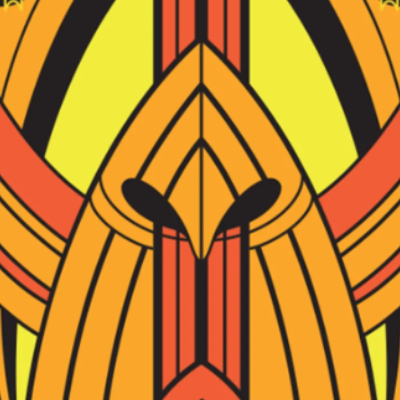- 5 Posts
- 21 Comments

 4·5 months ago
4·5 months agoHarry never got promoted because the writers never figured out how to evolve his function on the show.
This one is a bit of a copout, because Kim’s official role as the ship’s operations officer would absolutely have been appropriate for a higher ranking officer. It’s the same job Data held as a Lieutenant Commander on the Enterprise; if anything, the strange bit is that it was given to a green ensign in the first place.
Ultimately, the real explanation is a much sillier bit of bad writing. According to Garret Wang, quoted here:
Kim was probed, beaten, tortured and held the distinction of being the first Voyager crew member to die and come back to life. What more does a guy have to do to get promoted to Lieutenant for frak’s sake? To add further insult to injury, other crew members such as Tuvok (Russ) and Paris were being promoted, demoted and then re- promoted throughout the seven-year run of Voyager.
I’m not trying to be negative here; just saying it like it is. During the fourth season, I called writer/producer Brannon Braga and asked him why my character hadn’t received a promotion yet. His response? “Well, somebody’s gotta be the ensign.” Geez, thanks. Thanks for nothing.
Why it was important that “somebody’s gotta be the ensign” is a mystery to me.

 6·8 months ago
6·8 months agoI’ll stand by the position that the Enterprise augment virus arc was an error, and the “explanation” for Klingon ridges is the same one you should use for the bridge of the Enterprise looking like it was cobbled together from plywood and plastic beads. This issue was best left to Worf’s lampshade in DS9 Trials & Tribleations.
It’s really interesting which visual differences humans will accept unthinkingly and which we will demand answers for. The Klingon ridges thing comes up constantly, but I have yet to see anyone earnestly ask why all the characters in Lower Decks have huge eyes and unnaturally uniform coloration, or why hand phaser beams in TOS go so much more slowly than later phasers and why everyone agrees to stay really still while they are being fired.

It’s because citrus at high concentrations kills earthworms. Citrus in compost in normal quantities relative to other compostables seems to be fine, but you shouldn’t be trying to compost a huge pile of just pulp and orange peels in your back yard.
As for why this worked here, I’m sure there are a whole lot of things that aren’t earthworms living in a formerly rainforested spot in Costa Rica which can break that stuff down over 15 years.

 2·9 months ago
2·9 months agoNomadic people don’t just wander around aimlessly, and there are big differences in how desirable different territory is for nomadic hunter-gatherer humans. The principle is the same as with nomadic pastoralists: your group has a territory which can sustain them when hunted on/gathered from/grazed/etc over the course of the year, and your group will wander within that space in a deliberate pattern. If some other group decides to “just move on to” your group’s territory, hunting the animals and foraging the plants that your group knows they are going to need to survive the year, that’s an existential threat to you. And you can’t “just move on” yourself without wandering into the territory of yet more groups whose territory borders yours, and who will react violently to your presence for the same reasons.
Given the choice between fleeing to who knows where and fighting who knows who for the privilege of moving, or staying right where you are and fighting for the land you know your group can survive on, you stay and fight.
Humans spread out across the earth as the losers of these conflicts (those who survived, anyway) fled until they stumbled on new-to-humans territory, often displacing or eradicating groups of more “primitive” hominids they found there. This process continues until just about everywhere which humans can reach and which can support human life has humans in it. But expanding populations, the occasional natural disaster, and normal human frustration that their territory sucks while their neighbors have it great (which was often true; again, not all land is the same to a nomadic hunter/gatherer) meant that these conflicts were constantly reignited.

 4·9 months ago
4·9 months agoThere was organized violence deployed by groups of humans against other groups of humans long, long before anything we would recognize as warfare. Particularly brutal violence too, because the objective was not to conquer other people (something which only makes sense once agriculture is the dominant mode of sustinence), but to either drive off or exterminate a rival group so you can use their territory for yourself.
And we don’t even need to talk about people here: we have records of chimpanzees fighting small scale wars of harassment and extermination against neighboring groups.
Pre-modern, pre-civilization, pre-aggriculture, pre-you-name-it human life was far more violent than what we deal with today.

 9·9 months ago
9·9 months agoRegarding the future uniforms, the same uniforms appear in most portrayals of “future starfleet” during the TNG era, such as DS9 The Visitor. I don’t believe they are meant to indicate a connection between alternate futures beyond being the next step for Starfleet uniform designs (although the uniforms shown for a similar time period in Picard turn out to be different anyway).
Regarding your question more broadly, yes. And also no. Both, really.
I’m not sure Q recognizes or cares about the distinction between spinning up an entirely bespoke simulated reality for Picard to do his thing in, versus altering the past such that branching timelines are created and shuttling Picard’s consciousness between them before ultimately closing them off. Or whatever other myriad mechanisms an omnipotent being would have for triggering the events portrayed. Nor is there any real way for us the viewer or Picard the participant to distinguish between those things. What is real, what clearly matters both to Picard and to Q, is that Picard did pass a test, and that Picard remembers those events in a way which will influence his future actions and relationships.

 3·9 months ago
3·9 months agoSure. /u/williams_482

 2·9 months ago
2·9 months agoI still have a Reddit account and am willing to help people figure out Lemmy registration, but I do not moderate any active Reddit communities.

 1·11 months ago
1·11 months agoI count eight Kims (two of them only partially visible) in that shot of the prison cell, and there’s a fair bit of room around the corner for more to be hidden. I think it’s also easy to believe there are more cells containing more Kims just down the hall.
It’s reasonable to assume that the Defiant class’s 50 crew compliment is pretty close to a bare minimum already. 16-17 active at any one time is a pretty short list as it is, with roughly half that posted to the bridge during normal operations and most of the rest in engineering, plus a transporter chief, doctor, and other specialists. Having two shifts of reserves is crucial for covering both a long term assignment and for battle situations: you need to keep the crew as fresh as possible in the long run, and in combat you need those people to fill in for casualties and act as damage control, security, and emergency medical personnel. So unless Section 31’s strategic level idiocy extends all the way down to inane meddling in shipboard operations (possible, these guys are morons with dangerously inflated egos!), it should be safe to assume that the Anaximander was supposed to be staffed with about 50 crew.

 0·11 months ago
0·11 months agoThat sidesteps the question of why all of these comically evil people are okay with using this arbitrary contest to determine succession, instead of the usual route of organically murdering each other until someone emerges who is good enough at disposing of potential assassins that they keep the throne for a while?
I didn’t watch the movie, so I’m probably missing something. Did Georgiou also have to deal with a bunch of normal assassination plots after officially gaining the throne? Or are we to assume that by virtue of winning this contest, she is widely seen as too dangerous for anyone to attempt to usurp?

 1·11 months ago
1·11 months agoWho’s gonna do it? You? You, Lieutenant Barclay?
Yes?
Lieutenant Barklay and the huge, powerful, and successful paramilitary organization who employs him are exactly who is supposed to guard Federation worlds. Which is what they do.

 1·1 year ago
1·1 year agoThe showrunners said from a very early point that the two would not get together during the shows run, and I get the distinct impression that they actively enjoy trolling shippers. So this is pretty much exactly what I expected, and I’m perfectly happy with it.
(Also, look at Tendi in that last scene, when she gets a scan of Rutherford during a conversation about them being “just friends”. She saw something on that Tricorder which she didn’t expect, and then when Rutherford gets up and has his back turned, she’s clearly checking him out. Draw your own conclusions.)

 0·1 year ago
0·1 year agoThe overall Rutherford arc was less successful. I guess they seeded it previously, but I always just assumed his implant was on the fritz, so it was odd to see him suddenly blaming the ship.
I am at a loss as to how Rutherford’s implant could be flexible enough to function as part of his brain in day-to-day life, and yet somehow be incapable of helping him solve engineering problems on an old ship? Is there some kind of weird DRM installed that prevents it from opening schematics older than a couple years? Or is all the data on California class systems stored in a file format that they latest and greatest starfleet tech can’t open? Both of which would be rather colossal failures of Federation computer tech.

 1·1 year ago
1·1 year agoThis was a pretty solid episode with some very good jokes (the thing about creating a warp field with one nacelle was fantastic, for example), but I left feeling underwhelmed because of the bizare “the first officer is two LTJGs” thing. Lower Decks has had a shockingly strong track record of not doing things that strike me as immediately stupid, but this is really silly. “Ransom must be pulling another twisted prank, because he’s not this bad at his job” level silly. I think it’s still better than promoting Tilly to XO, but that’s a bar I had hoped this show would remain well clear of and a close shave is disappointing.
I think I understand why they did this: there’s no obvious non-specialist XO candidate of an appropriate rank in the main cast (arguably Shax, but he’s “only” a LT and does not seem ready for the job), and they didn’t want to just trot out a handwave and say they’ll be picking up the XO at the next starbase or something. I’d also theorize that they had planned to have two more seasons in which to work Mariner and Boimler into positions where they might actually make sense for an XO billet. But they aren’t there yet, and they both know it.
Also, gosh would that alternate universe explorer thing have been useful in DISCO S3. And probably Prodigy too. It’s also a dangerous can of worms to open for future stories, because having reliable access to random slightly different universes, apparently at different points in their timelines, is incredibly useful for both anticipating and solving problems in the “prime” universe. There’s also cool stuff they can do with it and I’m sure they will, so I’m trying to keep an open mind.
Finally, props to them for coming up with a more plausible reason for our heroes to literally save the universe: because someone connected to them got unwittingly thrown into a position of enormous influence, and deliberately picked them. It’s Zeus and company antagonizing Hercules, not Michael Burnham being central to solving five (?) entirely unrelated but galactically significant disasters, apparently by pure chance.

 1·1 year ago
1·1 year agoI wonder how common is it for a starship to make their “Senior Science Officer” a two person team.
Clearly many captains don’t see filling the role as a priority: None of the Enterprise D, Voyager, or (until this episode) the Cerritos had a senior science officer posted to the bridge. This makes a fair bit of sense on the grounds that “science” is an extraordinarily broad field and most of the practical, problem-solving sciencing we see tends to fall under the umbrella of engineering, so subject specialists and engineers wind up carrying the load as appropriate. As they should! No science officer can possibly hope to be comparably well versed in any given subject than a more junior officer who happens to specialize in it.
Therefore, although scientific acumen is obviously useful, as is getting as much scientific acumen as possible onto the bridge to quickly react to whatever weird shit a ship encounters, the larger part of the job is going to come down to synthesizing the larger knowledge base of the ship’s contingent of scientists into an actionable answer. The Senior Science Officer should be asking themselves not just “what do I know about this”, but “who else on the ship knows more about this” and, in a pinch, “which of these different ideas are we actually going to try.”
Having two people in the role is beneficial for getting more scientific knowledge on the spot and ready to be used, especially if the two people involved work well together, but it’s a potential liability in that final point where two people can reasonably disagree, but someone is going to have to make a call on what the best option is. In many cases that person is the captain, but when time is scarce and the choice is between things the captain doesn’t understand, the choice is really going to come down to the science officer. And what happens when the two science officers disagree?
In this case, I think the correct choice between our two science heroes would be Tendi. She’s (generally) good with other people, she has actual command experience (in combat situations, no less), she knows the bridge officers better, and they are more familiar with her. Further, T’Lyn is nominally a temporary posting who doesn’t seem to view herself as a serious candidate for the role. All the conventional decision-aiding factors seem to favor Tendi, and we all know she’s qualified.
Which leaves me wondering why this was a particularly difficult decision for Freeman, and why Data recommended this seemingly unconventional solution. Heck, Data barely even saw these two officers working together, as the two of them spent nearly the entire time working independently.
So maybe having multiple “senior” science officers is a normal state of affairs, and the expectation is that the captain will ultimately be able to resolve any final-stage disputes without needing an explicit head of the science division? That’s plausible if potential awkward, and there do seem to be plenty of consoles at the back of the bridge for multiple science specialists to be sitting in.

 1·1 year ago
1·1 year agoTransporter clones appear to be vanishingly rare. We’re aware of two (Thomas Riker and William Boimler), and the circumstances around Thomas Riker’s existence were clearly unheard of to any of the people investigating. Clearly this is not a thing that transporters normally do, or are even capable of outside of extremely unusual circumstances.
It also seems pretty dystopian to require the insertion of artificial genetic markers to make a person more easily recognizable. Would we expect “normal” identical twins to be treated similarly? Or actual clones?
I think the larger lesson on this incident from Starfleet’s perspective is that they need to beef up their internal security practices. Big shocker, that. Thomas Riker is neither the first nor last person to successfully impersonate a starfleet officer and cause major troubles in doing so, and most threat vectors can’t be solved by preemptively identifying likely perpetrators (such as this likely very offended transporter clone) and modifying them specifically to make infiltration more difficult.

 1·1 year ago
1·1 year agoVoyager’s original CMO was a Lieutenant Commander, which is presumably pretty typical for a ship of Voyager’s size. Bashir was commissioned as a Lieutenant Junior Grade to be the CMO on a backwater space station, so that’s presumably the bare minimum.
I would expect the Doctor’s first official rank (whatever that might be) to stick with him, plus promotion as appropriate. Adjusting it up and down based on posting would be a bizare thing to do for any other crewperson, and I’m sure The Doctor would object vigorously to such a thing.

 1·1 year ago
1·1 year agoit does explain why Bashir’s father was imprisoned but the Darwin station researchers were not.
Does it?
The Darwin Station researchers are human, as are their augmented subjects. Julian Bashir does not live on Earth at the time his augmentation is discovered. The Bashir family did not get this treatment done on Earth, and given the extreme lengths they went to get Julian treated, alongside Richard’s documented inability to keep a job consistently, it would have been utterly insane not to move to a different world (instead of a different city on Earth, as they actually did) after they got the treatment if this would also free them from any risk of legal repercussions.
Further, Strange New Worlds explicitly refers to this as a Federation law, and the principal reason why Illyrians are not welcome in the Federation.

 1·1 year ago
1·1 year agoThe only logical argument I can find in all of this, is that choosing a mate based on feeling/preference, instead of logic, might demonstrate that an individual is more emotional and therefore less logical. And I think we all know how Vulcans feel about things that are not logical and/or things that act upon their feelings…
Personally, I don’t see that having a preference in a mate, even one that steps outside the heteronormative, is a flaw in their logic. If you enjoy your time with your mate, and that makes you a better, more productive individual, then I fail to see a problem.
I don’t see any evidence that Vulcans don’t completely agree with your own personal stance here.
Vulcans clearly do act upon personal values, desires, preferences, etc, that we as humans would view as emotional responses. “I want [a cookie/you to live long and prosper/to have galactic peace/to solve this math equation/etc]” is, for a human, a statement inherently rooted in an emotional assessment. The Vulcans themselves, however, clearly do not view these things as emotional expression.
We see partnerships which don’t produce children, and despite Vulcans having no filter whatsoever when it comes to criticizing others for being “illogical”, nobody seems to have anything to say to Sarek for apparently having no children with his last wife Perrin. When Tuvok is separated from his wife, he acknowledges on multiple occasions that he misses her because he wants to be able to spend time with her; he certainly doesn’t bemoan the missed opportunity to fulfill a societal obligation to pop out more babies.
We don’t have explicit counterfactuals here, but we all know that ultimately comes down to Doylist reasons. There’s no reason we should assume that Vulcan society shares Rick Berman’s personal sense of morality in this area.


The “Riker Maneuver” blooper absolutely killed me.